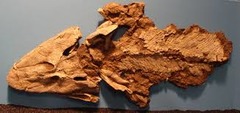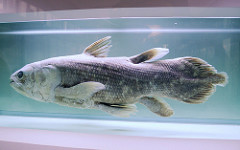Evolution Exam 1- Geologic Time – Flashcards
Unlock all answers in this set
Unlock answersquestion
Precambrian, 4.5 to 2.5 billion years ago, Environmental events-formation of the planet. Unstable and turbulent weather, primitive atmosphere devoid of oxygen. Granite, sedimentary rocks, and red beds formed. Biological Events- from absence of life through the chemical origin of life. Protobionts formed. Anaerobic and photosynthetic bacteria evolve. Heterptrophism established. The least number of fossils in the rock record would be found (arche - beginning) beginning animal period (carbon traces but no fossils)
answer
Archeozoic
question
Precambrian period, 2.5 billions years to 542 million years ago Environmental events- vast volcanic activity. Mountain formations. Sedimentary rock formation. Glaciation with moist cool to dry cool climates. Oxygen released to atmosphere through photosynthesis , ozone layer established. Biological Events- Autotrophism established. Rise of eukaryotes. Algae diverse. Protozoans, worms and other softbodied animals present. Prokaryotic organisms still abundant. Snowball earth
answer
Proterozoic
question
Cambrian, Ordovician, Silurian, Devonian, Carboniferous, Permian
answer
Paleozoic (age of Amphibians)
question
542 to 499 millions years ago Environmental events- large oceans with a mild climate. paleo-equator through west central North America. Biological Events- all invertebrate phyla present. many species of trilobites. Algae complex. The Cambrian Explosion. starfish, brachiopods, trilobites Haikouichthyes-fish like organisms Conodonts- jawless eel like Walcott- Burgess Shale-uplifting of the Cambrian
answer
Paleozoic -Cambrian
question
499 to 444 million years ago Environmental events-oceans were greatly enlarged. Much of the land submerged. Warm mild climates into higher latitudes. Biological events- abundant trilobites, crinoids, brachiopods, cephalopods, and other marine invertebrates. First vertebrates appear. Primitive plants. Age of Invertebrates still in the ocean, Epifaunal, infaunal, Benthic-on the bottom of the ocean. Ostracoderms- no jaws, saltwater, heavy dermal armor, bone was originally for storing energy. major fishes. The _________________________ came to a close in a series of extinction events that, taken together, comprise the second largest of the five major extinction events in Earth's history in terms of percentage of genera that became extinct. The only larger one was the Permian-Triassic extinction event. cold conditions. Third largest most of life was in the sea, reduced trilobites, brachiopods, and graptolites. sea level dropped then glaciation.
answer
Paleozoic- Ordovician
question
444 to 416 million years ago Environmental events- relatively flat continents with continental seas. Mountain building in Europe with mild climates. Biological Events- Invasion of the land by vascular plants and arthropods. Diversity of graptolites and marine invertebrates. Eurypterids were dominant. Fish were primitive. arthropod-become most abundant trilobites. Eurypterials- are an extinct group of arthropods that are related to arachnids and include the largest known arthropods to have ever lived. They are members of the extinct order Eurypterida; which is the most diverse Paleozoic. sea scorpions develop tougher bone. spiny sharks
answer
Paleozoic- Silurian
question
416 to 359 million years ago Environmental events- small inland seas with the formation of mountains. Variation of arid lands to lands with abundant rainfall. Biological events- first amphibians appear. abundant sharks and fish. Presence lungfish. Marine invertebrates abundant. Land plants increasing. Age of Fishes. plant changes appearance more land masses Placaderm-giant armored fishes. ray finned( actinopterygii)-Eurpterids and the lobe finned (sarcopterygii)-tetrapods colelacanth- most important find, lobe fin, Tiktaalik. Plant explosion- first primitive forrest, protogymnosperms, horsetails. Ammonites first appear during this time period. warming of climates could cause the loss of some species to mostly marine and shallow warm water organisms. Three quarters of all species on Earth, series, shallow seas most affected.
answer
Paleozoic- Devonian
question
359 to 315 million years ago Environmental events- Much mountain formation with inland seas. Warm to hot swampy environments. Biological events- radiation of the amphibians. Many bony fish and sharks. first winged insects. many crinoids and brachiopods. Great coal forests including club mosses, horsetails, and giant ferns High oxygen, dominant swamps, trees falling create coal, giant insects. railroad rocks are carboniferous , amphibians growing in size and diversity, transitions to amphibians to reptiles (origin) reptiles at first were small and unassuming, adaptation (scales)
answer
Paleozoic- Carboniferous- Mississippian
question
315 to 299 million years ago Environmental events- shallow inland seas and cool swamp forests. Glaciation in the Southern Hemisphere. Biological events- Origin of reptiles. Diversity of amphibians. Giant insects. Great coal forests including club mosses, horsetails, and giant ferns.
answer
Paleozoic-Carboniferous-Pennsylvanian
question
299 to 251 million years ago Environmental events- wide spread mountains. Appalachians formed. Moist to cold dry climates. Pangaea intact. Ending with glaciation and an ice age. Biological events- Adaptive radiation of the reptiles displacing the amphibians. Major extinction of many species of plants and animals. Modern insects increase. Gymnosperms appear. fungi forming on land more, more mycornhizae-makes food more available, symbionant relationship with earliest plants. plants begin to dry out except protogymnosperms-broad to strappy need like leaves. reptiles begin to adaptivly permeate. Pelecosaurs-fin on back to regulate temperature. Therapids- mammal like reptiles- teeth, warm bloodiness, some small, not a lot of hair on sensory areas (pits) (rodents). some were giants looked like cats or rodents large teeth and claws still have bony fish uncalm of the super continents lack of photosynthesis, release of methane gas. bottom of ocean a lot of methane. Largest loss At the end of the ______, over 96% of marine species and many terrestrial species became extinct, possibly because intense volcanic activity warmed the Earth's climate. Called the Great Dying 96% of species.
answer
Paleozoic- Permian
question
Triassic, Jurassic, Cretaceous
answer
Mesozoic Age of Reptiles
question
251 to 201 million years ago Environmental events- Two continental depositions separated by an intervening marine complex. Varied sandstone and limestone deposits. Climates arid with wide spread deserts. Biological events- Variety of reptiles. Thecodonts dominate. Presence of mammal-like reptiles and early mammals. First dinosaurs. Many marine invertebrates. Ferns, cycads, and conifers dominate. rise of dinosaurs, pangaea made of Laurasia and Gonwana. Panthalassic Ocean, was the vast global ancestral Pacific ocean that surrounded the supercontinent Pangaea, during the late Paleozoic and the early Mesozoic eras. Panthalassa giant seas It included the Pacific Ocean to the west and north and the Tethys smaller Ocean to the southeast. It became the Pacific Ocean, following the closing of the Tethys basin and the breakup of Pangaea. Pleisiosaur and Pterosaurs. The __________________ period ended with a mass extinction, which was particularly severe in the oceans; the conodonts disappeared, as did all the marine reptiles except ichthyosaurs and plesiosaurs. Invertebrates like brachiopods, gastropods, and molluscs were severely affected. In the oceans, 22% of marine families and possibly about half of marine genera went missing. Climate change, flood basalt eruptions and asteroid, many ideas.
answer
Mesozoic- Triassic
question
201 to 145 million years ago Environmental events-Climates generally mild. Antarctica and Canada were temperate. Beginning of the Sundance Sea and the Gulf of Mexico. Continents with shallow seas. Sierra-Nevada mountains form. Biological events- Giant reptiles common. Diversity of dinosaurs and marine invertebrates. Early mammal populations increasing. Archaeopteryx and toothed birds. Ferns, cycads, and conifers dominate. Great age of dinosaurs flying and swimming dinosaurs appear; first toothed birds. pangaea started breaking up. ginkos, and pine, oceans full of marine reptiles, large crocodiles. Dinoflagellates- responsible for killing fish, red tides. Small dinos tell us about the ecosystem. Big ones are small percent. 1000 species 500 species of genera. flowering begins more.
answer
Mesozoic-Jurassic
question
145 to 65.5 million years ago Environmental events- spread of inland swamps and seas. Formation of the Andes, Rockies and Himalayas. Continued break up of Pangaea. Increased geologic instability. Climates cooling. Asteroid strikes near the Yucatan Peninsula. Biological events- Dinosaurs dominate before extinction. Extinction of the giant reptiles and many marine invertebrates. Elimination of one- fourth of all animal families. Reduction of cycads, ferns, and gymnosperms. Marsupials and placental mammal populations increase. Rise of flowering plants. The impact of a large body with the Earth may have been the punctuation mark at the end of a progressive decline in biodiversity during the Maastrichtian Age of the ______________________ Period.
answer
Mesozoic-Cretaceous
question
Tertiary and Quarternary
answer
Cenozoic Age of Mammals
question
65.5 to 55.8 million years ago Environmental events- Mountain building. Temperate to subtropical climates. Separation of South America and Africa. Biological events- Archaic mammals dominate. Large flightless birds. Subtropical plants. woody flowering plants present. reminiscence of dinos, nothing really exists, Earth will cool, oxygen. The death of dinosaurs , ammonites, flowering plants.
answer
Cenozoic- Tertiary- Paleocene
question
55.8 to 39.9 million years ago Environmental events- Heavy rainfall with mountain erosion. Land connection between Europe and North America. Biological events- Modern orders of animals. Adaptive radiation of placental mammals. First horses, giant birds, subtropical forests. went through heating, evening chilly, greenland tropical, polar regions-forest, the cooling starts and plants make more. go into grasses, cacti adn gymnosperms or angiosperms? modern mammals come into their own, grazing ate soft leaves- some order get large. Horses have their beginnings-Hydracotherium-oldest, Eohippus-oldest small have 4 toes front, 3 toes back, snout with canine teeth. omnivorous-back is elongated, but not swayed, vertebrate goes to the end of the tail. camels in south america do well are now lamas. evolution of citations- dolphins and whales. Tethys Pakieetus- legs, walk on land, elongated body of an ocean animal, ear region approaching whales. ambulocetus- natans-walking swimming whales front swimming, hinds walking with flippers with hooves. Basilosaurus - whale not lizard. found red river in Louisiana, teeth whale and ears, no functionality tiny legs except for mating. Primates -manipulative hands, eyes forward. The end of the Eocene was marked by the Eocene-Oligocene extinction event, also known as the Grande Coupure.
answer
Cenozoic- Tertiary- Eocene
question
39.9 to 29 million years ago Environmental events- Climates mild, beginning to cool. Tethys Sea dominate. Nebraska was similar to modern Louisiana. Biological events- Whales and primates developing. Temperate plants. Giant foraminiferans. Archaic mammals extinct. Slender of transition old to new period. Antarctic more isolated. connection between angiosperms-especially monocots taking off legumes. recognize horses, camels, elephants, birds, raptors, eagles. singing birds, Oceans-condrites-shark megaladon teeth never found a whole-fed upon whales, group hunting with whales. first penapeds. large otters. elephants- to water manatees. Monkeys-canarindies,Cercopithecidae, old world monkeys No prehensial tail, facial difference. New world monkeys cadalinys,Callitrichidae, Cebidae, Aotidae, Pitheciidae, and Atelidae- prehensial tail useful
answer
Cenozoic-Tertiary-Oligocene
question
29 to 5.3 million years ago Environmental events- Development of plains. Climate moderate. Biological events- Vast grasslands with grazing animals. Modern sub-families present. Radiation of the large carnivores. First hominids.
answer
Cenozoic-Tertiary-Miocene
question
5.3 to 2.6 million years ago Environmental events- Continental elevation. Cool climates. Land bridge between North and South America. Asia and North America connected at Berring Strait. Biological events- The peak of mammals. Most genera of plants and animals present. Large carnivores.
answer
Cenozoic-Tertiary- Pliocene
question
2.6 million to 12000 years ago Environmental events- Three ice ages in which glaciers covered most of North America, Europe, and Asia. The climates ranged from cold to mild. Biological events- Development of modern species of plants and animals. Decline of great mammals. Development of early humans
answer
Cenozoic-Quarternary-Pleistocene
question
12000 years to present Environmental events- End of the third Ice age. Climates is warming. Geological and geological conditions similar to today. Reminants of the ice ages present in glaciers. Great Rift Valley in Africa forms. Biological events- Dominance of modern plants and animals. Rise of herbaceous plants. Extinction of giant mammals. Man has great impact on the planet.
answer
Cenozoic-Quarternary-Recent
question
Tiktaalik- extinct sarcopterygian (lobe-finned fish) from the late Devonian period, about 375 Ma (million years) ago, having many features akin to those of tetrapods (four-legged animals). has a possibility of being a representative of the evolutionary transition from fish to amphibians. "fins" of Tiktaalik have basic wrist bones and simple rays reminiscent of fingers.

answer
Tiktaalik
question
comprises the first four-limbed vertebrates and their descendants, including the living and extinct amphibians, birds, mammals, reptiles and some ancient, exclusively aquatic creatures such as the Acanthostega. Tetrapods evolved from the lobe-finned fishes around 390 million years ago in the middle Devonian Period, nearest common ancestor of all living amphibians (the lissamphibians) and all living amniotes (reptiles, birds, and mammals), along with all of the descendants of that ancestor. Stegocephalia is a larger group equivalent to some broader uses of the word "tetrapod"
answer
tetrapod
question
They follow the oldest known living lineage of Sarcopterygii (lobe-finned fish and tetrapods), which means they are more closely related to lungfish, reptiles and mammals than to the common ray-finned fishes.The coelacanth, which is related to lungfishes and tetrapods, was believed to have been extinct since the end of the Cretaceous period.

answer
Coelacanth
question
Ammonites first appear during this time period
answer
Devonian
question
Egg-laying
answer
oviparous
question
live birth, mom provides support and nutrients
answer
viviparous
question
producing living young from eggs that hatch within the body
answer
ovoviviparous
question
not dinos-marine reptile. have long necks, paddle like fins, found in the ocean. Australia-opalmines finding them
answer
Pleisiosaur
question
Winged reptiles that lived during the time of dinosaurs. not dinosaurs, small, but larger in Jurassic.
answer
Pterosaurs
question
Great age of dinosaurs flying and swimming dinosaurs appear; first toothed birds
answer
Jurassic



